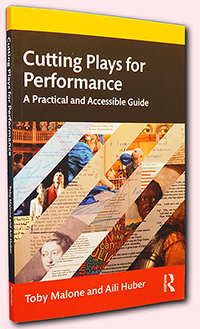Cutting Up
Cutting Plays for Performance: A Practical and Accessible Guide
Toby Malone and Aili Huber (Routledge, 2022)
Allow me to quote myself at the start of this book review. This is from my review of the American Shakespeare Center’s 2014 production of William Shakespeare’s Timon of Athens.
The pertinent skills for making this Timon such great theater come from several quarters. First is the "cut" of the play, or the edited script, this one done by erstwhile ASC actor Benjamin Curns.
Lauding the cut of a play, especially putting it first on the laudation list, is not common practice: note my using quotation marks around cut in the quote. Even mentioning "the cut” ventures into a shady fringe of theater of which many audiences are unaware and might be aghast to discover. “Cut” of the play? Cut, OMG, Shakespeare?!
 Yet, cutting plays is a foundational practice in theater, especially with the scripts of Shakespeare and his contemporaries. With their book Cutting Plays for Performance, Toby Malone and Aili Huber pull the curtain on that practice. In addition to explaining the many purposes and parameters for making cuts, they offer practical tips and anecdotal experience for new hands at what is a daunting and can be a dangerous task.
Yet, cutting plays is a foundational practice in theater, especially with the scripts of Shakespeare and his contemporaries. With their book Cutting Plays for Performance, Toby Malone and Aili Huber pull the curtain on that practice. In addition to explaining the many purposes and parameters for making cuts, they offer practical tips and anecdotal experience for new hands at what is a daunting and can be a dangerous task.
The experience they tap into is not just theirs. Malone has a PhD in Shakespearean textural analysis from the University of Toronto and has worked on several productions in Canada (including Stratford Festival) and New York. Huber has an MFA in directing from Mary Baldwin University and the American Shakespeare Center and has directed plays at the professional, college, and high school level. Her Pigeon Creek Shakespeare Company’s Much Ado About Nothing is reviewed on Shakespeareances.com. The two authors further add immense value to their lesson book by picking the minds of a wide array of veteran cutters. The list of 19 interviews includes such need-no-introduction Shakespeareans as Tim Carroll, Antoni Cimolino, Ralph Alan Cohen, Kate Mulvany, Tina Packer, and James Shapiro. Their narrative is peppered with opinions, examples, and anecdotes directly from these luminaries.
I have seen and read so much Shakespeare that, while watching productions of his plays, I’m innately aware of subtle textual cuts, excised scenes, combined characters, and rearrangements. All of these aspects of textual editing come under Huber’s and Malone’s definition of cut, and saying “That was a good cut” is more than insider speak for the after-show get-together. My Shakespeareances reviews often analyze how such textual manipulations work or don’t work: how they enhance the play’s themes and theatrical experience or undermine the play’s themes and narrative effect.
Back to my Timon review; I explain precisely what made Curns’ cut a good one:
The play has been streamlined and not only given a logical progression but a sense of urgency, too. Gone are the redundancies and extraneous observing characters. Not gone, surprisingly, is the Fool's scene, in which the Fool (Sarah Fallon) and cynical Apemantus (Josh Innerst) team up to out-insult various Athenian lords. The Fool is still a bizarre and fleeting addition—he or she never shows up again—but the scene further evolves the role of Apemantus, which will come to significant fruition in the second half.
Cutting plays is not just about what you take out, but also what you leave in and why. Malone and Huber discuss all the whys, along with the wherefores for the various whys, pertinent to specific types of productions, from full-cast Broadway shows to small-cast touring troupes, from conceptualized adaptations to abbreviated and censored school performances. Shakespeare is prominent in their study, but he shares the pages with ancient Greeks, Middle Age passion plays, early modern English fellows, Restoration theater managers, and 19th century playwrights. Huber and Malone also give explicit direction on why anything that is not in the public domain cannot be cut, including other cuts of public domain plays.
Right up front, Malone and Huber tackle the dogma that cutting any playwright’s work, especially Shakespeare’s, is a cardinal sin. “To an outsider, cuts may seem audacious, hubristic, or even sacrilegious,” they write in the book’s introduction. “To the purists, cuts may seem like unnecessary brutality inflicted on a beloved text, perpetrated out of fear of a classical play’s inherent intricacy. In fact, cutting is not only common but also necessary.”
So necessary that Shakespeare himself probably cut Shakespeare, as the authors demonstrate in the differences among printed versions of his plays during and shortly after his lifetime. Shakespeare even jokes about play cuts—as defined above—in Hamlet, A Midsummer Night’s Dream, and Love’s Labour’s Lost. The original venues for Shakespeare’s works were as varied in his time as they are in ours: the large outdoor Globe, the intimate indoor Blackfriars, at court and in courtyards, private performances in manor houses, touring productions in taverns. The different spaces, cast sizes, and audiences dictated the versions to be performed. Time was a factor, too. Shapiro explains how available sunlight in London varies significantly from spring to midsummer to fall. Maybe Kenneth Branagh could gain acclaim by doing an entire-text Hamlet for cinemas, but Shakespeare could not have pulled that off in the Globe with available spring or autumn sunlight.
Cutting Plays for Performance originated as a Kennedy Center American College Theater Festival workshop that Huber and Malone taught in 2019, which they titled “The First Thing We Do, Let’s Cut All the Lawyers: How to Cut Shakespeare.” The workshop revealed their different approaches to cutting Shakespeare and a general lack of instructional material on the subject. “Although rarely acknowledged publicly, cutting is almost universal,” they write. However, “Rarely is anyone taught how [emphasis in original]. Cutting is traditionally positioned as a skill, to ‘feel’ your way through. To operate on blind faith and instinct has its merits—both of us learned to cut in the crucible of pre-production. We have developed a sense of cut pitfalls, and on some points reached different conclusions. We want to save others from the pain and embarrassment of taking a deeply flawed cut to a production team—or worse, an audience—and highlight aspects of the process where reasonable people might disagree.”
No hubris in that, not when both authors and their interviewees describe some of the “pain and embarrassment” they’ve experienced in their cutter careers.
The three keys to their book’s value are in its subtitle: A Practical and Accessible Guide. It is practical, laying out essential principles and providing tips for each stage of the entire process, from deciding between scissors or a computer spreadsheet for making the cuts to dealing with resistant actors. They also acknowledge different techniques and approaches to the task while warning against willy-nilly stealing cuts from other productions. Though they present some specific examples of ways to cut a text, they keep true to the book’s intent of being a guide; it is not merely a compendium of textual cuts across the Shakespeare, Marlow, Jonson, Sophocles, Webster, Wycherley, Ibsen, Chekhov, Shaw, Wilde, and Strindberg canons. They offer additional tools, advice, and a newsletter on their website, https://www.cuttingplays.com/index, where you also can purchase the book. Furthermore, their appendix on staging licensed texts is a comprehensive legal brief that every theater should make required reading for its producing artists.
All good stuff, but it’s the Accessible in the subtitle that makes Cutting Plays for Performance such a fun read for theater fans. Malone and Huber fill their narrative with enlightening anecdotes and insider snark. After relating a hilarious account about Mulvany interpolating into Shakespeare’s Julius Caesar a passage from Plutarch (the play’s source), Huber and Malone conclude that “If you have an idea this brilliant, don’t let potential pedantic audience members stop you.” Tying cuts to performance spaces, they advise cutters to consider, “Is the house large enough that those in the cheap seats brought binoculars, or small enough the furthest seat is within a three-point shot of the stage?”
I do not know Malone, but I met Huber when I visited the Pigeon Creek Shakespeare Company for the Shakespeareances Cannon Project in 2018. After subsequent correspondence and get-togethers, I can see her fun personality rippling through Cutting Plays for Performance. Just from reading the book, I sense that Malone is probably something of a cut-up, too. It reads as a lively conversation.
I didn’t raise an eyebrow of concern until the last pages as they advocated for giving text editors credit in programs, and even extra credit if their cutting the play is in addition to being the director or dramaturg. My journalism career is split evenly between jobs as a writer and as an editor, so I know firsthand that the editor is sometimes more prominent in the final published version than the writer. Yet never ever does an editor get a share of the byline. Of course that doesn't bother me as a writer, even when editors most often make my stories better. It doesn't bother me as an editor, either. It’s a point of honor among us editors that we do the vital work unseen to the public, much as play cutters have since the ancient Greeks.
Then I decided to lead this book review with my Timon review and discovered that I had, indeed, credited the cutter. Furthermore, I knew Curns cut the play only because I asked members of the cast. So, I now add my voice to that of Malone and Huber: let’s give play cutters their due.
“Sometimes, the power of a cut is not in what it removes, but what it reveals,” they write at the end of the book’s introduction. “Happy trimming.”Eric Minton
November 28, 2023
Comment: e-mail editorial@shakespeareances.com
Start a discussion in the Bardroom



 Find additional Shakespeareances
Find additional Shakespeareances